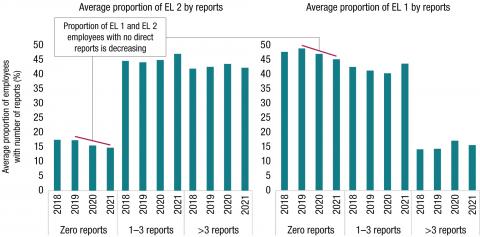Future-fit hierarchies and structures
What the COVID-19 experience has shown is that public-sector work practices don’t need to be fixed in stone. A lot of flexibility in the workplace is possible. Hierarchy can be streamlined. And giving staff responsibility for doing their job can frankly achieve better results.31
Dr Gordon de Brouwer PSM, National President, Institute of Public Administration Australia (IPAA)
Optimising organisational layers and spans of control can empower staff, reduce bureaucracy and increase accountability.32 International civil services, such as the United Kingdom, are reviewing their structures to ensure their hierarchies are designed for rapid problem-solving and decision-making.33 The Thodey Review concluded that current organisational arrangements in the APS lack the flexibility and responsiveness needed to meet the needs of a rapidly changing and connected operating environment.34
Over time, the composition of the APS workforce has changed. There has been an increase in the number of staff at the more senior APS levels, with a reduction in the APS 1 through to APS 4 levels. This change in composition—while retaining the same number of classification levels—has the potential to slow down decision-making. Multiple layers of decision-making was one of the main barriers to high performance identified by almost one-third of respondents to the 2021 APS Employee Census.
Figure 2.1: Changing proportion of employees by classification (2002 to 2021)

As the APS adopts more agile ways of working, strengthened organisational design practices will be important to tailor teams and management structures to suit business needs, strategic priorities and type of work. This includes, where appropriate, embracing agile approaches of operating to ensure an efficient flow of information and a faster decision-making process.
The spans of control for senior managers in the APS have broadened over recent years. Since 2019, the proportion of Executive Level (EL) 1 and EL 2 managers with no direct reports has decreased. In 2021, an average of 42% of EL 1 and 45% of EL 2 employees had between 1 and 3 direct reports.
Figure 2.2: Average proportion of EL 1 and EL 2 employees with number of direct reports

The Hierarchy and Classification Review, established in March 2021, is reviewing both Senior Executive Service (SES) and non-SES classifications against best practice and emerging workforce needs.35
Review of APS hierarchy and classifications: building a future-fit APS workforce
Delivering for Tomorrow: the APS Workforce Strategy 2025 set out how the APS will reshape its workforce and structures, embrace new capability models and streamline workforce management practices to compete globally and drive innovative, citizen-centric solutions.
As part of the Australian Government’s APS reform agenda, Delivering for Australians, the Hierarchy and Classification Review is underway to review SES and non-SES classification levels and structures. The review is about simplifying decision-making structures, uplifting capability and reimagining the culture of the APS to encourage faster decision-making, empower the workforce, foster innovation, and enable greater flexibility and mobility across the APS. The review will explore opportunities and make recommendations that accommodate the diversity of APS functions and best position the workforce for the next 25 years.
The review is being led by independent panel members, Dr Heather Smith PSM, Ms Kathryn Fagg AO FTSE and Mr Finn Pratt AO PSM.
The panel is working through its findings and will provide the final report to the Australian Public Service Commissioner by the end of 2021 for consideration.
31Dr Gordon de Brouwer PSM, National President, IPAA. (2020). The importance of public services in the world of COVID-19. 14 July.
32Deloitte Development LLC. (2019). Spans and Layers for the Modern Organization. n.d.
33Government of the United Kingdom. (2021). Declaration on Government Reform. 15 June.
34Commonwealth of Australia. (2019). Our Public Service, Our Future. Independent Review of the Australian Public Service. 13 December.
35APSC. (2021). APS Hierarchy and Classification Review 18 March.



